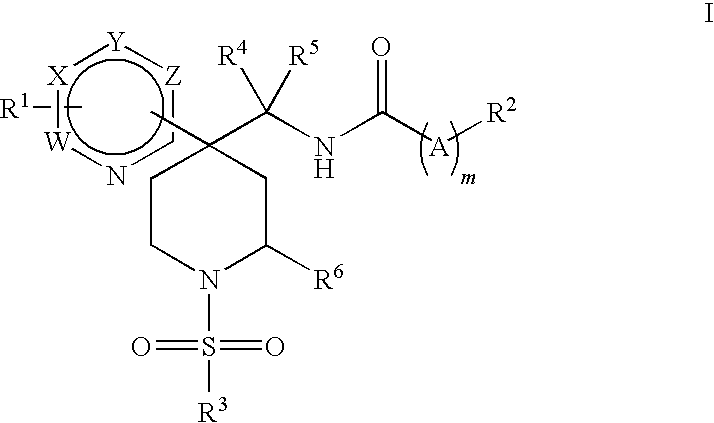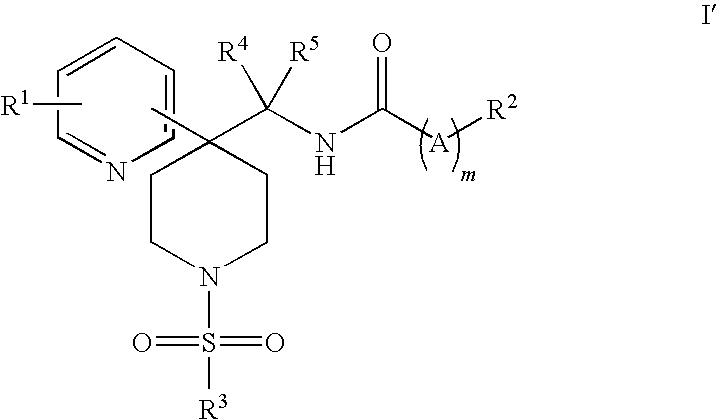Heteroaryl piperidine glycine transporter inhibitors
a technology of heteroaryl piperidine and transporter inhibitors, which is applied in the field of debilitating psychiatric disorders, can solve the problems of difficult to differentiate between the two in the clini
- Summary
- Abstract
- Description
- Claims
- Application Information
AI Technical Summary
Benefits of technology
Problems solved by technology
Method used
Image
Examples
example 8-1
[0284]
2,4-Dichloro-N-{[4-(3-methylpyridin-2-yl)-1-(propylsulfonyl)piperidin-4-yl]methyl}benzamide
tert-Butyl 4-cyano-4-(3-methylpyridin-2-yl)piperidine-1-carboxylate
[0285]A solution of tert-butyl 4-cyanopiperidine-1-carboxylate (6.3 g, 30 mmol) and 2-fluoro-3-methylpyridine (5 g, 45 mmol) was formed in toluene (50 mL) and cool in an ice-bath while potassium hexamethyldisilazide (72 mL, 0.5 M in toluene) was added dropwise. The mixture was then allowed to warm to room temperature over night. The solution was poured into water (200 mL) and extracted with ethyl acetate (3×200 mL). The combined organic phases were dried over magnesium sulphate (anhydrous), filtered and evaporated to an orange oil. Purification by flash column chromatography on silica gel using dichloromethane containing 5% ethyl acetate as eluent afforded the desired product: tert-butyl 4-cyano-4-(3-methylpyridin-2-yl)piperidine-1-carboxylate as a white solid: 1H NMR δ (ppm)(CDCl3): 8.41 (1 H, dd, J=1.4, 4.7 Hz), 7.54-7....
example 9
[0293]
2,4-Dichloro-N-{1-[4-(3-methylpyridin-2-yl)-1-(propylsulfonyl)piperidin-4-1]ethyl}benzamide
tert-Butyl 4-(1-aminoethyl)-4-(3-methylpyridin-2-yl)piperidine-1-carboxylate
[0294]A solution of tert-butyl 4-cyano4-(3-methylpyridin-2-yl)piperidine-1-carboxylate (603 mg, 2.0 mmol) was formed in toluene (10 mL) and cooled in an ice-bath while methyl magnesium bromide (1 mL, 3 M in diethyl ether) was added dropwise. The resulting slurry was stirred at room temperature for 24 hours then more methyl magnesium bromide (1 mL, 3 M in diethyl ether) was added and the mixture stirred at room temperature for a further 6 hours. The mixture was cooled in an ice-bath and quenched by the addition of methanol (3 mL). After 10 minutes at 0° C., sodium borohydride (113 mg, 3.0 mmol) was added and the mixture allowed to warm to room temperature over 15 minutes. The mixture was again cooled in an ice-bath and saturated aqueous ammonium chloride (5 mL) was added dropwise. The mixture was then poured into ...
example 10-1
[0297]
N-{[4-(3-bromopyridin-2-yl)-1-(propylsulfonyl)piperidin-4-yl]methyl}-2,4-dichlorobenzamide
tert-Butyl 4-(3-bromopyridin-2-yl)-4-cyanopiperidine-1-carboxylate
[0298]2,3-Dibromopyridine (5 g, 21 mmol) and tert-butyl 4-cyanopiperidine-1-carboxylate (3.0 g, 14 mmol) were reacted in the presence of potassium hexamethyldisilazide (17.1 mmol) using the method described in example 8-1 to afford the desired product: tert-butyl 4-(3-bromopyridin-2-yl)-4-cyanopiperidine-1-carboxylate: 1H NMR δ (ppm)(CDCl3): 8.53 (1 H, dd, J 1.5, 4.6 Hz), 7.97 (1 H, dd, J=1.5, 8.0 Hz), 7.18 (1 H, dd, J=4.4, 8.0 Hz), 4.23 (2 H, br s), 3.29 (2 H, br s), 2.48 (2 H, br s), 2.15 (2 H, br s), 1.47 (9 H, s).
4-(3-Bromopyridin-2-yl)-1-(propylsulfonyl)piperidine-4-carbonitrile
[0299]A solution of tert-butyl 4-(3-bromopyridin-2-yl)-4-cyanopiperidine-1-carboxylate (1.0 g) was formed in dichloromethane (3 mL). Trifluoroacetic acid (1 mL) was added and the mixture stirred at room temperature for 4 hours. The mixture was t...
PUM
| Property | Measurement | Unit |
|---|---|---|
| pH | aaaaa | aaaaa |
| time | aaaaa | aaaaa |
| temperature | aaaaa | aaaaa |
Abstract
Description
Claims
Application Information
 Login to View More
Login to View More - R&D
- Intellectual Property
- Life Sciences
- Materials
- Tech Scout
- Unparalleled Data Quality
- Higher Quality Content
- 60% Fewer Hallucinations
Browse by: Latest US Patents, China's latest patents, Technical Efficacy Thesaurus, Application Domain, Technology Topic, Popular Technical Reports.
© 2025 PatSnap. All rights reserved.Legal|Privacy policy|Modern Slavery Act Transparency Statement|Sitemap|About US| Contact US: help@patsnap.com



